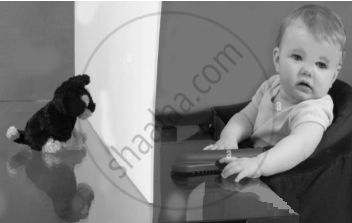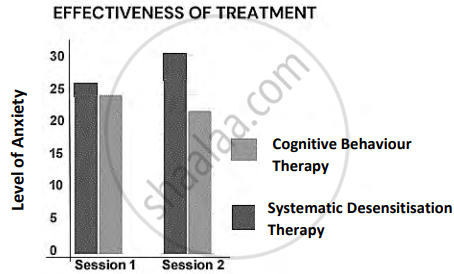Advertisements
Advertisements
प्रश्न
Describe concrete cognitive development during childhood.
उत्तर
In Piaget’s theory, a stage of cognitive development occurring roughly between the ages of seven and eleven is the stage of concrete operations. According to Piaget, a child’s mastery of conservation marks the beginning of this stage. Logical thought emerges in this stage.
The key developments at this stage are as follows :
Conservation: Children at this stage understand that physical entities (weight, length, amounts) remain fixed so long as nothing is added or taken away from it, though it might appear different. Understanding of this nature’s constant is known as conservation. The various kinds of conservation are :
Conservation of substance: Two identical clay balls are presented. The subject admits that they have equal amounts of clay. If one ball is deformed into the shape of a “sausage”, the subject will still say that both contain equal amounts of clay at this stage.
Conservation of length: Two sticks are aligned in front of the subject and he admits their equality. Now if one of the sticks is moved to the right, and the subject is asked whether they are of the same length, the subject will admit that they are still of the same length.
Conservation of members: Two rows of clay balls are placed in one-to-one correspondence subject admits that both rows have an equal number of balls. Now, one of the rows is elongated or contracted and the subject is asked whether both the rows still have the same number of balls. They admit equality.
Conservation of liquids: Two beakers are filled to the same level as water. The subject sees that they are equal. Now, liquid of one container is poured into a tall tube. The subject is asked whether each contains the same amount. At this stage, They agree that each contains the same amount.
Conservation of area: In two identical cardboard’s same number of identical wooden blocks are placed in identical portions. Then the subject is asked whether each cardboard has the same amount of space remaining. The experimenter then scatters the blocks on one of the cardboard. The subject is asked the same question. In both cases, the subject admits that the same amount of space is left.
Reversibility: In this stage, children can solve the questions mentally. They do not need to measure or weigh objects. For example — In the famous Muller-Lyer illusion :
In the figure, in step 1, a child agrees that stick A and stick B are equal. In step 2, stick B appears longer than stick A. But children in the concrete stage are capable of mentally reversing the shafts of the arrows to its original configuration, would admit it to be the same as stick A.
Categorization: This includes abilities such as ‘seriation’, ‘transitive inference’ and ‘class inclusion’.
- Seriation: It refers to the ability to arrange items along a dimension such as weight (lightest to heaviest) or color (lightest to darkest).
- Transitive inference: It refers to the ability to recognize a relationship between two objects by knowing the relationship between each of them and a third object.
For example, Amanda is shown three sticks — yellow, red and green. She has been told that the yellow stick is longer than the red one and the red one is longer than the green one, then without physically comparing the yellow with the green one, she can tell that the yellow stick is longer than the green one.
Class inclusion: Class inclusion is the ability to see the relationship between the whole and its parts. For example—A bunch of ten flowers (seven roses and three carnations) is shown to the children at this stage and asked whether there are more roses or more flowers. They realize that roses are a sub-class of flowers and therefore there cannot be more roses than flowers.
Spatial thinking: Children at this stage can understand the spatial relationships, i.e., they have a clear idea of how far it is from one place to another and how long it takes to get there. They have the ability to use maps and models.
Inductive and deductive reasoning :
Children at this stage use inductive reasoning, rather than deductive reasoning. It refers to that type of logical reasoning that moves from particular observation about members of a class to a general conclusion about the class.
For example, My dog barks so do Jerry’s dog and Melissa’s dog. So, it looks as if all dog’s barks.
The children at this stage, however, cannot very clearly think of hypothetical propositions. Also, they cannot understand the broad meaning of abstract concepts such as freedom, integrity. Intellectual growth is still incomplete.
APPEARS IN
संबंधित प्रश्न
Answer the following question briefly:
Who put forward the theory of moral development?
Answer the following question:
Briefly explain what is meant by gender identity.
Answer the following question briefly:
Explain the pre-conventional stage of morality.
All individuals have a certain knowledge of themselves and some beliefs about their own characteristics. What is this known as?
In a study on Moral Development, subjects were presented with a hypothetical situation involving conflicting moral values or moral dilemmas. They were asked to make judgements on this situation and give their reasoning.
- Who proposed the Theory of Moral Development referred to above?
- Briefly explain each of the following stages of Moral Development:
- Obedience and Punishment Orientation.
- Good girl-Good boy Orientation.
- Social Contract Orientation/Legalistic Orientation.
| Shireen and Rafi are siblings aged five and six years respectively. They like to play at home pretending as king and queen. They wear their mother's gowns and decorate the chair like a throne. They believe that their toy horse is real and ride it. They want their mother to play with them and get upset when she refuses to play. They do not understand that their mother is tired and needs rest. |
- Name the stage of Cognitive Development that Shireen and Rafi are going through.
- Discuss any six features of the stage of Cognitive Development that Shireen and Rafi are experiencing.
Observe the image shown below and identify the stage of cognitive development.

Study the relation between the first two words and then fill in the fourth word.
Good boy-Good girl orientation : Conventional level : : Universal ethical principle orientation : ______.
| Ananta, aged 8 years and her sister Rashmi, aged 4 years, are given a set of objects like coloured marbles, toy animals and plastic fruits. They are asked to sort and classify these objects. Ananta can sort the objects based on colour, shape, and size easily. However, Rashmi cannot sort these objects based on their features. |
- According to Piaget’s theory, what stages of cognitive development are Ananta and Rashmi currently in? (2)
- Contrast the stages of cognitive development of Ananta and Rashmi on any two bases. (2)
|
Ten participants, all having a phobia of spiders, were divided into two groups for a study that aimed at determining the effectiveness of Cognitive Behaviour Therapy (CBT) and Systematic Desensitisation. Each group underwent two sessions of each therapy. At the end of every session, the effectiveness of therapies was measured based on a questionnaire on Anxiety, which was filled by the participants. The responses of the participants have been depicted in the graph given below.
|
- Refer to the graph shown above and determine which treatment was more effective. Contrast the effectiveness of Cognitive Behaviour Therapy (CBT) and Systematic Desensitisation. (3)
- Discuss any two symptoms and any two causes of Phobias. (4)

